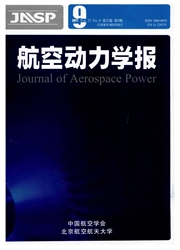

 中文摘要:
中文摘要:
为了探讨某S弯进气道出口畸变在其后风扇级内的演变过程以及对风扇级性能的影响,在单独对该进气道进行抽吸控制数值研究并优选出最佳方案后,将最佳方案应用到进气道加风扇级的全流道,进而展开全流道数值研究,着重探讨了抽吸控制前后风扇级性能及内部流场结构变化.结果表明:吸气后风扇级整体性能有较大幅度提升,堵塞流量及最大效率分别增加约0.63%和0.57%;进气道出口低能流体在接触转子之前始终聚集在沿程截面底部,所占区域面积沿流向逐渐减小;接触转子至动叶前缘区间内,畸变流体沿动叶旋转方向的相反方向发生偏移,最终覆盖约3个流道;静叶中畸变流体所处流道内的静叶吸力面发生严重的流动分离,且分离主要发生在50%叶高以下,吸气后略有减弱.
 英文摘要:
英文摘要:
To investigate the evolution process of an S-shaped air intake exit distortion as well as its influence on the downstream fan-stage performance, a series of suction control for the single air intake were carried out at first. And then the best suction solution was selected and applied to the whole structure numerical simulation. Results show that the choked mass flow and the maximum efficiency of the fan-stage increase about 0.63% and 0.57% respectively after suction. In addition, the low energy fluid gathering at cross section bottom decreases ceaselessly as it gets to the tip station of the rotor hub. Since it attaches the tip of the rotor hub, the circumferential location of this low energy fluid migrates gradually along the opposite rotation direction and finally covers about 3 flow passages at the rotor blade front edge. Under effect of the air intake flow angle increase caused by the non-uniform air admission and the adverse pressure gradient in the rear part of the flow passage, serious flow separation occurs at the stator blade suction side but mainly exists at 50% span and below and weakens after suction.
 同期刊论文项目
同期刊论文项目
 同项目期刊论文
同项目期刊论文
 patial discretization error in an artificial benchmark model of oblique laser incidence by finite vo
patial discretization error in an artificial benchmark model of oblique laser incidence by finite vo Analysis on capabilities of density-based solvers within Open FOAM to distinguish aerothermal variab
Analysis on capabilities of density-based solvers within Open FOAM to distinguish aerothermal variab A Second Order Radiative Transfer Equation and Its Solution by Meshless Method with Application to S
A Second Order Radiative Transfer Equation and Its Solution by Meshless Method with Application to S Analysis on transient conjugate heat transfer in gap–cavity–gap structure heated by high speed airfl
Analysis on transient conjugate heat transfer in gap–cavity–gap structure heated by high speed airfl Numerical simulation of infrared signature emitted by liquid rocket plume using wide band k-distribu
Numerical simulation of infrared signature emitted by liquid rocket plume using wide band k-distribu Effect of air temperature on combustion characteristics and NOx emissions from a 0.5 MW pulverized c
Effect of air temperature on combustion characteristics and NOx emissions from a 0.5 MW pulverized c Experimental study of the impact of holes-typesuction on the flow characteristics in a high-load com
Experimental study of the impact of holes-typesuction on the flow characteristics in a high-load com First-principles molecular dynamics study on temperature-dependent dielectric function of bulk 3C an
First-principles molecular dynamics study on temperature-dependent dielectric function of bulk 3C an Temperature-dependent dielectric function of germanium in the UV-vis spectral range: A first-princip
Temperature-dependent dielectric function of germanium in the UV-vis spectral range: A first-princip Characterization of combustion and NOx emissions with respect to over-fire air damper opening in a d
Characterization of combustion and NOx emissions with respect to over-fire air damper opening in a d Simulation of flow behavior of particles bycluster structure-dependent drag coefficient model for ch
Simulation of flow behavior of particles bycluster structure-dependent drag coefficient model for ch An effective inversion algorithm for retrieving bimodal aerosol particle size distribution from spec
An effective inversion algorithm for retrieving bimodal aerosol particle size distribution from spec Study of topology and vortex structure in turbinecascades with tip clearance under differentincidenc
Study of topology and vortex structure in turbinecascades with tip clearance under differentincidenc Effect of the anthracite ratio of blended coals on the combustion and NOx emission characteristics o
Effect of the anthracite ratio of blended coals on the combustion and NOx emission characteristics o Experimental study on the characteristics of heat transfer and flow resistance in a turbulent pipe f
Experimental study on the characteristics of heat transfer and flow resistance in a turbulent pipe f Evaluation on cold modeling flow field for a down-fired 600 MWe supercritical boiler with multi-inje
Evaluation on cold modeling flow field for a down-fired 600 MWe supercritical boiler with multi-inje Modeling of a rotational supercavitating evaporator and geometrical characteristics of supercavity i
Modeling of a rotational supercavitating evaporator and geometrical characteristics of supercavity i Annaland Martin van Sint.Hans Kuipers, Dongsheng Wen, Discrete particle modeling of granular tempera
Annaland Martin van Sint.Hans Kuipers, Dongsheng Wen, Discrete particle modeling of granular tempera A de?ciency problem of the least squares ?nite element method for solving radiative transfer in stro
A de?ciency problem of the least squares ?nite element method for solving radiative transfer in stro Simulation of flow behavior of particles by cluster structure-dependent drag coefficient model for c
Simulation of flow behavior of particles by cluster structure-dependent drag coefficient model for c Aerodynamic characteristics within a cold small-scale model for a down-fired 350 MWe supercritical u
Aerodynamic characteristics within a cold small-scale model for a down-fired 350 MWe supercritical u Numerical simulation of natural convection in a square enclosure filled with nanofluid using the two
Numerical simulation of natural convection in a square enclosure filled with nanofluid using the two Inner and Outer Secondary-Air Distance-Effect Study within a Cold Small-Scale Model of a New Down-Fi
Inner and Outer Secondary-Air Distance-Effect Study within a Cold Small-Scale Model of a New Down-Fi New over-fire air arrangement and its air ratio optimization determined by aerodynamic characteristi
New over-fire air arrangement and its air ratio optimization determined by aerodynamic characteristi 期刊信息
期刊信息
